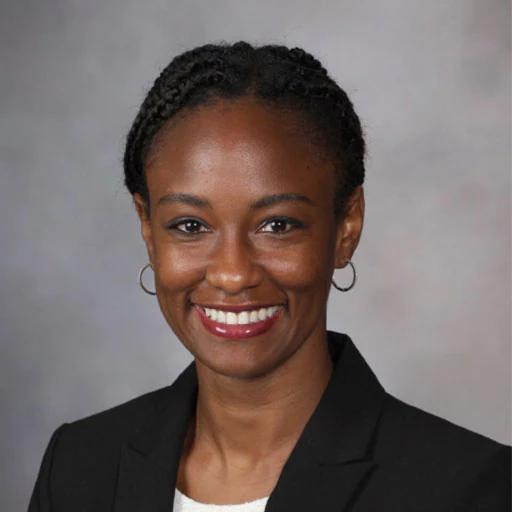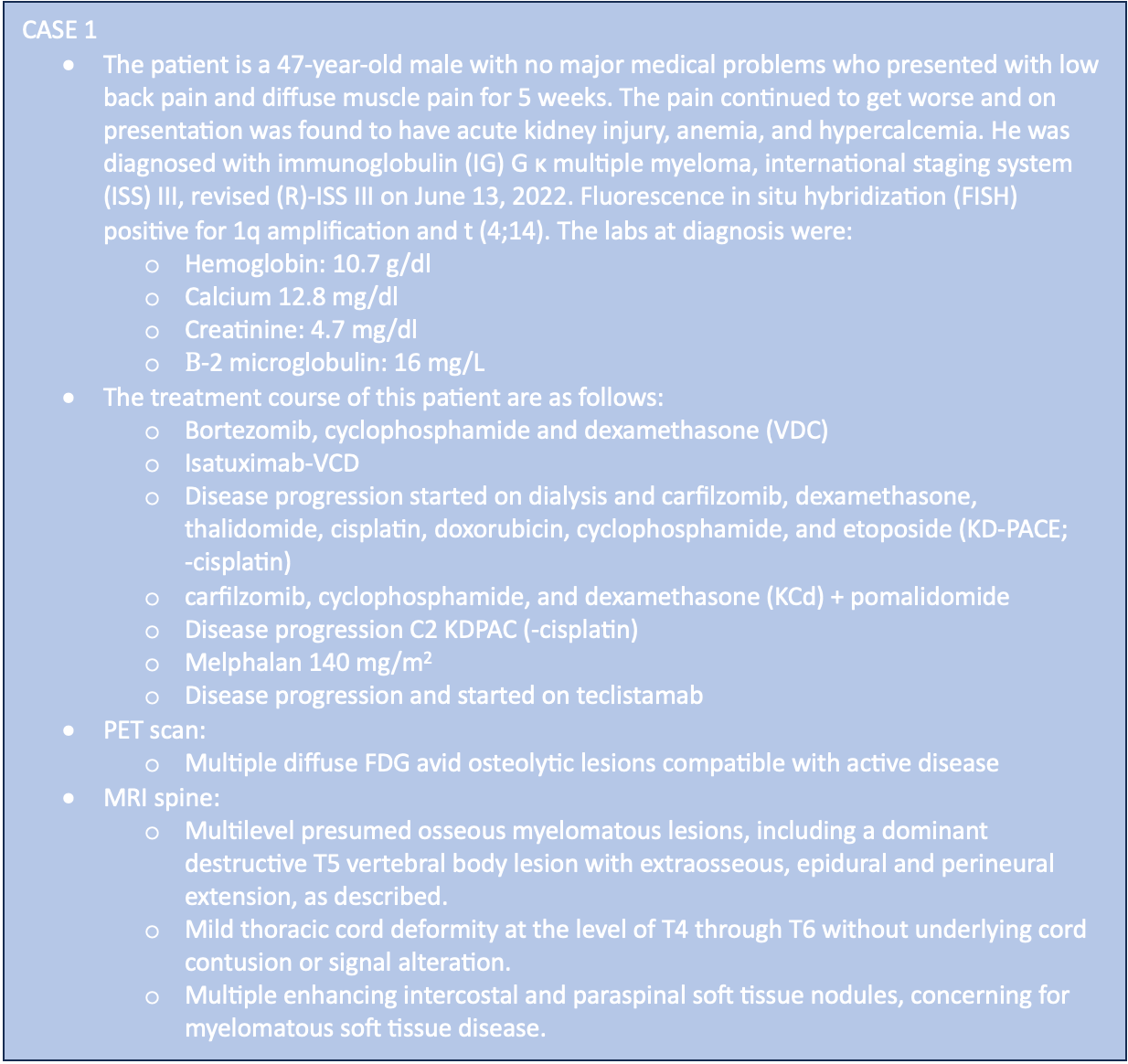Analyzing a Patient Case and Assessing Treatment After Relapse in Multiple Myeloma
Clinicians discuss treatment options for advanced-stage multiple myeloma and consider the effects of renal disfunction.
In a recent Around the Practice program, physicians specializing in multiple myeloma reviewed current treatment options for patients with advanced-stage disease. They discussed how treatment can vary based on the number of relapses and the effects of renal dysfunction in myeloma. The clinicians specifically discussed a case in which a patient with high-risk disease received multiple lines of treatment.
The discussion was moderated by Carolina Schinke, MD, associate professor of medicine at the Myeloma Center at the University of Arkansas for Medical Sciences. She was joined by Luciano Costa, MD, PhD, associate director for clinical research in the O’Neal Comprehensive Cancer Center and associate professor of hematology and oncology at the University of Alabama at Birmingham, School of Medicine; and Binod Dhakal, MD, MS, associate professor of medicine at the Medical College of Wisconsin, Division of Hematology.
Carolina Schinke, MD
Associate Professor of Medicine at the Myeloma Institute for Research and Therapy at the University of Arkansas for Medical Sciences

Luciano Costa, MD, PhD
Associate Director for Clinical Research in the O’Neal Comprehensive Cancer Center and Associate Professor of Hematology and Oncology at The University of Alabama at Birmingham, School of Medicine

Binod Dhakal, MD, MS
Associate Professor of Medicine at the Medical College of Wisconsin, Division of Hematology

Joselle Cook, M.B.B.S
Assistant Professor of Medicine at the Mayo Clinic

Schinke: During today’s discussion, we’ll review clinical scenarios, share our insights, and discuss recent updates in the management of patients with relapsed/refractory multiple myeloma. We’ll begin with the clinical scenario of
Case 1
The patients case

Schinke: This is an interesting case. Unfortunately, it’s a patient who is young with high-risk cytogenetics at diagnosis and [who underwent] an aggressive [treatment] course, with rapid relapse after each treatment. The patient [underwent a] transplant, which is not good, and then, most recently, [received] teclistamab-cqyv [Tecvayli], which is also progressing. When we look at patients with relapse in multiple myeloma, we distinguish those with early relapses compared with those with later relapses. How would your treatment options differ for patients with early relapse compared with those with later relapse.
Costa: That’s a great point. This case illustrates the extremes very well. First, kudos to Dr. Dhakal for having a clinical trial that could [include] this patient. Renal dysfunction, particularly severe renal dysfunction, is very common, yet it excludes patients from most clinical trials. We end up having a large population of people for whom we don’t have high-quality evidence. This [case] both predicted and materialized high-risk disease with patients going through essentially all classes of therapy in a period of just over a year. It’s dramatic and, unfortunately, not that uncommon. This is very different from somebody who gets to 4 lines of therapy over 15 years. Patients with early relapse usually have had sensitive disease, so they need some [additional] therapy. They get put on maintenance therapy, and they’re progressing years later. Then [doctors] have the luxury of picking from several different regiments, essentially trying to introduce a new drug with a new mechanism of action that the patient has not been exposed to yet. Dr. Dhakal tried this in every step by using high-dose occulators, and introducing immunomodulatory drugs [IMiDs] or monoclonal antibodies early on. In a short period of time, those main cornerstones of myeloma therapy had already been exhausted. It then becomes necessary to have a drug with a new mechanism of action. It’s fortunate that we now have those therapies that are available for patients with renal dysfunction, which was not the case just a few months ago.
Schinke: If it were feasible and possible from an insurance standpoint, and if a patient had that aggressive disease and relapsed early, would you consider these bispecific antibody treatments sooner?
Dhakal: Definitely. If there had been no teclistamab approved at that point in time, this patient would have been a hospice candidate. The reason this patient is surviving so far is because we have teclistamab available. This patient is a young guy with 2 young kids, and he has no options. One question is lines of therapy, but class refractoriness already tells you that patients need to have these therapies available right away. This patient relapsed right after the first month. I told him, this was not a good sign. When you’re refractory to a CD30 monoclonal antibody to a proteasome inhibitor and then added IMID after, and he progressed on that, this tells you that he is not going to do well. Having these therapies is good, but at the same time, we also need a mechanism to allow these patients to access these therapies early on because [no therapy] was working on this patient.
Schinke: What would be your next step?
Dhakal: The next step would be starting talquetamab-tgvs (Talvey). Last week, the patient had grade 1 cytokine release syndrome [CRS], and I’m confident that he’s going to respond to that. He also had a rapid relapse after teclistamab. That has been his pattern. The longest response duration so far was with teclistamab, so I’m hoping that he’ll get talquetamab. The one thing I would like to add is, that while he was already showing signs of progression, I collected his T cells for CAR T-cell therapy, but he has 0 CAR T cells manufactured. The challenge is manufacturing CAR T cells while the patients are on active bispecific antibody therapy, especially heavily treated patients like this. I’m hoping that talquetamab will provide some benefit, but in the long term, this is a very challenging case for the long-term outcome.
Schinke: That’s a very good point regarding the collection of T cells and when we do that during the treatment course.
EP: 1.Patient Case Presentation: A 47-Year-Old Man With Multiple Myeloma
EP: 2.Treatment Options for Patients With Relapsed/Refractory Multiple Myeloma (RRMM)
EP: 3.Talquetamab in RRMM: Results From MonumenTAL-1
EP: 4.Teclistamab Plus Talquetamab in RRMM: Data from the RedirecTT-1 Study
EP: 5.Teclistamab plus Nirogacestat in RRMM: The MAJESTEC-2 Study
EP: 6.Bispecific-Based Combinations Under Evaluation for Patients with RRMM
EP: 7.Toxicity Management in Patients With RRMM Receiving Bispecific Antibodies
EP: 8.Treatment Approaches for Frail Patients With RRMM
EP: 9.Patient Case Presentation: A 62-Year-Old Woman With High-Risk Multiple Myeloma
EP: 10.Available Options for CAR T-Cell Therapy in Patients With RRMM
EP: 11.Ciltacabtagene Autoleucel in Patients With MM: Efficacy and Safety Data From CARTITUDE-1
EP: 12.Clinical Pearls for Community Physicians Treating Patients With RRMM With CAR T-Cell Therapy
EP: 13.Toxicity Management in Patients With R/R MM Receiving CAR T-Cell Therapy
EP: 14.Exploring Novel Treatment Options in Patients With RRMM
EP: 15.Analyzing a Patient Case and Assessing Treatment After Relapse in Multiple Myeloma
Navigating AE Management for Cellular Therapy Across Hematologic Cancers
A panel of clinical pharmacists discussed strategies for mitigating toxicities across different multiple myeloma, lymphoma, and leukemia populations.